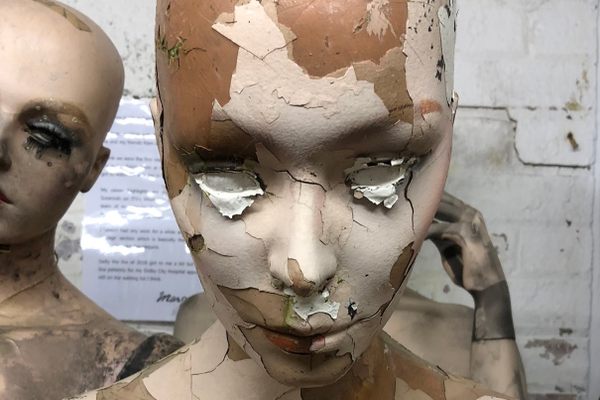Jumpstart Your Halloween With These ’90s Horror TV Intros
Fear and intrigue, together in the opening titles.


Happy Halloween! If you’re having trouble getting into the spooky spirit, there is a surefire way to fill yourself with that unique seasonal mix of dread and fun that you had before it was crushed by the joyless weight of adulthood: check out the credits sequences of the great horror and sci-fi anthologies of the 1990s.
While seasonal anthology shows like American Horror Story are becoming popular these days, episodic horror anthologies like The Twilight Zone, in which each installment is its own little self-contained story, have been successful for decades. But the 1990s was a high water mark for the genre. From Tales from The Crypt and Goosebumps, to lesser-known series like Monsters and Freddy’s Nightmares, horror anthology shows could be found all over the airwaves. And while they each trafficked in similar tales of macabre misfortune, supernatural horror, and black irony, and many even shared the concept of a wise-cracking host, the shows were differentiated by their spooky, distinctive intro sequences.
Unlike on shows with a recurring cast and central story or location, these anthologies had to provide viewers with a looser introduction to their program—something that communicated more of a tone and feel than any specifics pertaining to character or plot. Thanks to this need for a broader introductory segment, most intros to horror anthologies acted as impressionistic little horror movies unto themselves. Watching these intros invokes a specific feeling of fun fear. They’re like a straight shot of Halloween spirit.
Probably the most classic and memorable of these intros belongs to HBO’s Tales From The Crypt (1989-1996). The wordless introduction follows a long tracking shot through an evocative haunted house, gliding through a cobweb-strewn foyer, past a candle-lit desk, through a secret passage, and behind a bookcase. Eventually it leads the eye through the titular crypt, where the Cryptkeeper finally pops out to punctuate the journey. It’s not unlike being strapped into an on-rails haunted house attraction. The journey is made all the more creepy by a spooky Danny Elfman–penned theme, and random sound cues like screams, wolf howls, and lightning strikes. Without uttering a word, the intro tells its own vague story, and ushers you into a world of frights.
The anthology show Monsters (1988-1991) offered a similar trip through a haunted house, playing around with more banal imagery to create an uncanny effect. As the show opens, the camera pulls into what seems to be a quaint suburban house, but it turns out that this normal scene is not so normal after all—the family inside is revealed to be monsters! Even though they’re cyclopses and potato creatures, the family banters as they sit down to watch TV. Reality is turned a bit upside down, and you get the idea that you’re in for some strangeness.
Even shows that relied on a more established franchise had their own great intros. The horror collection Freddy’s Nightmares: A Nightmare on Elm Street: The Series (1988-1990) used its own well-known film series as a jumping off point, then established its own feeling of fright. Freddy’s Nightmares briefly recapped the story of the titular dream monster through a series of stills, then begins panning around a neon-lit boiler room set while images of screaming people were superimposed on screen. This was Tales From The Crypt with Freddy Krueger as the Cryptkeeper.
Where Tales from the Crypt and others took you on a haunted house ride, some other intros took a more impressionistic approach. In the more kiddie-focused shows of the time like Goosebumps (1995-1998) or Are You Afraid of The Dark (1990-2000), the audience is presented with a series of short clips and images that don’t so much tell their own story, but work to evoke a feeling of dread. There’s a banging shutter, or a full moon, or an attic with nothing other than a sinister-looking clown doll in it. The only thing really being communicated is a sense of fear.
While most anthology intros were largely wordless, at least one show used voiceover to great effect. The Outer Limits (1995-2002) was a revival of a 1960s series that is often best remembered for the eerie monologue that ushered in each episode, and the new series smartly just updated it. “There is nothing wrong with your television. Do not attempt to adjust the picture. We are now controlling the transmission,” begins the famous opening monologue. The voice tells you that you will now be taken to a place where anything is possible, presenting a loss of control and a feeling of dread. All the while, bizarre imagery takes over the screen underneath. A giant eye is opened, bodies fall endlessly through space, these frights are of a more sci-fi nature, but the effect is much the same.
With the popularity of shows like the modern sci-fi anthology Black Mirror, we may be seeing a return to the form for anthology horror. But now that our primary style of viewing is to binge watch, intros and credit sequences seem to be on their way out, getting shorter and much less elaborate. We may never again see such purely evocative slices of horror like we had in the 1990s. Of course we could also just be getting old. Which is the scariest part of all.









Follow us on Twitter to get the latest on the world's hidden wonders.
Like us on Facebook to get the latest on the world's hidden wonders.
Follow us on Twitter Like us on Facebook